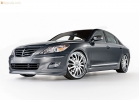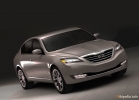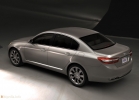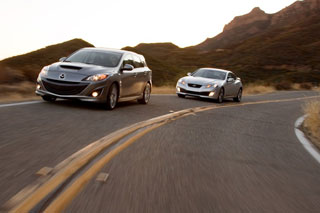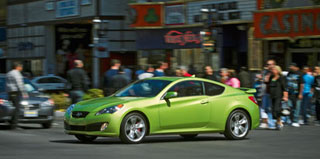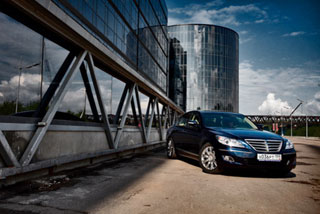Hyundai Genesis test drive since 2008 sedan
Hyundai Genesis Coupe: Lime for lemon
 Closing our eyes to small flaws, in the dry residue we get a bright appearance, a powerful engine and rear -wheel drive on one side and a thoughtful machine gun and a rustic salon on the other.
Closing our eyes to small flaws, in the dry residue we get a bright appearance, a powerful engine and rear -wheel drive on one side and a thoughtful machine gun and a rustic salon on the other. The unusual word Genesis, one of the meanings of which is translated from Greek as a birth, is great for the new generation of Hyundai rear -wheel drive cars.
The origin of the Korean company Hyundai began in 1967, during the third republic, which was nominally considered democratic, and in fact adhered to military principles of government. During this period, the company's activities were regulated by the state. In the 60s, Hyundai produced only a few cars and one freight model of the American Ford concern. The first model of the car was Hyundai Pony, presented at the Turin Auto Show in October 1974. The development of Pony was engaged in the former Director of British Leland Malcolm Turnbull, who designed Austin Marina, and Pinifarina’s Italian studio masters worked on the appearance. The first popular and world -famous car was Hyundai Sonata, the first generation of which appeared in the fall of 1988. And in 1991, a sports model Coupe went into production.
Today, Hyundai has a new Genesis Coupe, built on the basis of the Hyundai Genesis luxury sports sedan. According to the representatives of the Hyundai themselves, the sedan offers the dynamics of the fifth series and the interior of the seventh BMW series. Boldly.
The Korean coupe was represented in February 2009 in the United States as a model of 2010, with eight combinations of two engines and three types of checkpoints. Americans with satisfied faces burn rubber for all grandmas, and on the open spaces of the Russian Federation you can officially buy only two of them: with a 2.0-liter turbo engine and two types of transmission, a five-stage machine and six-trained mechanics.
The price of a sport-compartment begins with 1,259,900 rubles, which significantly reduces the bar in the segment, because the closest competitor Infiniti G37 3.7 V6 7at is available only if there are at least 2,149,000 rubles. With this comparison, of course, you can argue, remembering the wound in equipment, etc., but the beauty is priceless. And Genesis is beautiful. The brown appearance of an expensive car, muscular tides on the sides, aggressive squint of the head optics, neat feed with two exhaust pipes integrated into the bumper and large 18-inch wheels make you pay attention to the Korean compartment of neighbors by stream. If you add a bright light green color to this, then the neighbors will smile and show the thumb. By the way, the color has a noticeable effect on the perception of the machine, it is worth comparing, for example, a solid gray or noticeable red.
Unfortunately, the interior looks much boring and easier. However, modesty has its advantages: it only positively affected the price. Great seats: moderately tough, with good lateral support, covered in excellent skin. A tall driver will easily be located at the wheel, despite the fact that it is regulated only in height. On the back sofa, the place is enough only for a reticulus or dog, it will be inconvenient for an adult, and you can get on it only through the passenger door, the driver’s side is not intended for passengers passengers. If necessary, the back of the rear row can be folded by increasing the tank compartment capacity from 284 to 332, but why?
 The central display with blue illumination does not have sufficient contrast, and on a bright day you have to strain your eyes to make out the text on it. However, he does not carry any vital information, and this minor drawback can be experienced. The control panel is replete with dark gray buttons framed by gray plastic under chrome, but their number does not cause discomfort, they are pleasant tactile, have a clear feedback and intuitive designations, any climate control or audio system can be configured without distracting from the road. Noise isolation also leaves much to be desired, but a powerful 360-vat Infinity audio system with a 6-disks CD, which supports CD/MP3, equipped with 8 speakers and an amplifier, will help forget this trifle.
The central display with blue illumination does not have sufficient contrast, and on a bright day you have to strain your eyes to make out the text on it. However, he does not carry any vital information, and this minor drawback can be experienced. The control panel is replete with dark gray buttons framed by gray plastic under chrome, but their number does not cause discomfort, they are pleasant tactile, have a clear feedback and intuitive designations, any climate control or audio system can be configured without distracting from the road. Noise isolation also leaves much to be desired, but a powerful 360-vat Infinity audio system with a 6-disks CD, which supports CD/MP3, equipped with 8 speakers and an amplifier, will help forget this trifle. The heart of the car is a motor. And in the Russian market, Genesis Coupe is available with only one engine with a two -liter aluminum turbo engine, developing 213 horsepower at 6,000 revolutions per minute, with a maximum torque of 302 N*m at 2000 (!) Revolutions per minute. This engine was developed by the Union of such cargo whales as Mitsubishi, Hyundai and Chrysler, so it can be found in a whole range of cars of these companies in a wide variety of variations. The system of continuous change in gas distribution phases for intake and graduation camshaft made it possible to increase power and reduce harmful emissions. With minimal changes, the same engine is used in the Mitsubishi Lancer Evolution X, which indicates a spaciousness for tuning.
On the Russian market, only two types of transmissions are available, this is a manual 6-speed and 5-speed machine. The most delicious sports 6-speed machine ZF 6HP19, which is used in the BMW X3, Audi S4 (B6, B7) and the senior Genesis Coupe model with V6 3.8L, as usual, did not get to us. On the test we had a car with a five -speed automatic. The automatic transmission, despite the flexibility of the motor and excellent traction on the bottom, overshadows the incendiary of the races for the first second or one and a half after the pressing of the accelerator pedal does not happen at exactly. But if you still survived these moments and the place in the stream has not yet closed, then you risk risking from the rest of the participants in the movement at an impressive speed will no longer want to stop. And the Korean will rush out of the row in a row, responding to any steering wheel and allowing him to play a little until ESP is triggered.
The rolls in corners are present, but not critical, successful balance of controllability and comfort. The joints of the Moscow overpass are noticeable, but if you do not focus on this, then in general the suspension of the compartment (Macpherson racks with a pine stability stabilizer and the spring multi-link with a stabilizer behind) works at 5. School-insulation in Korean leaves much to be desired.
I was not pleased with the biting appetite: during the test period, the average fuel consumption was in the region of 16 liters per 100 km. However, the sensation of the demolition of the rear axle and the roar of the exhaust tuned to sports notes are much greater than the numbers on the gas checks.
Closing our eyes to small flaws, in the dry residue we get a bright appearance, a powerful engine and rear -wheel drive on one side and a thoughtful automatic machine and a rustic salon on the other. Is it worth giving for this 1,329,900 rubles for a version with an automaton or 1,259,900 rubles for the pleasure to indicate to the Korean, for what kind of transfer to go? The answer suggests itself: for a similar amount, of course, you can purchase a PEUGEOT RCZ or Renault Laguna Coupe compartment, but the classic rear -wheel drive compartment is much more expensive.
Artem Ivanov






Source: Carclub.ru


